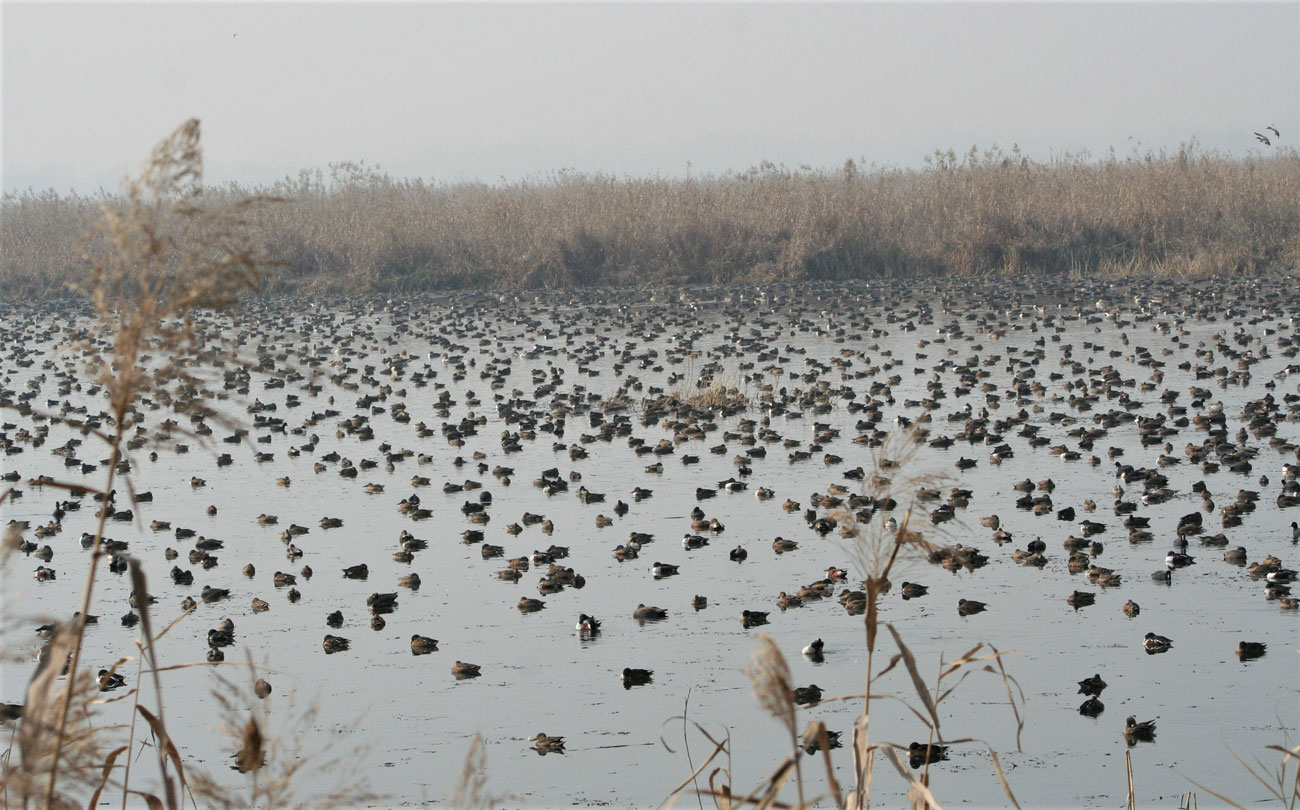Save Kashmir’s Wetlands
First published on
December 04, 2023
By Bhavya Iyer
Around 18 km. from Srinagar lies Shallabugh, a shallow wetland fed by rainwater, snowmelt, the Anchar Lake and Sindh Nallah. Designated a Conservation Reserve and declared a Ramsar site in recognition of its importance as a habitat for several migratory bird species in 2022, Shallabugh, which lies in the Jhelum floodplains, however continues to be plagued with issues ranging from water quality and siltation to encroachment.
Wetland On The Brink
Spread across an area of 1,675 hectares, Shallabugh plays host to several migrants, including threatened species such as the Steppe Eagle Aquila nipalensis, Pallas’s Fish-eagle Haliaeetus leucoryphus, Black-bellied Tern Sterna acuticauda, Eastern Imperial Eagle Aquila heliaca, Yellow-eyed Pigeon Columba eversmanni and Wood Snipe Gallinago nemoricola. The wetland performs several crucial ecosystem services such as flood control and aquifer recharge, and contributes to local livelihoods through fisheries and tourism. The eco-tourism potential of the wetland has been recognised by local authorities. However, a 2020 study on water quality across different seasons found markers of high pollution, with water quality markedly worse in winter than in summer. This is bad news for winter migrant species. Eutrophication on account of fertiliser run-off from nearby orchards and farms, and sewage is also impacting the wetland.

Ducks in Kashmir’s Hokersar wetland, when the lake had sufficient water. Photo: Intesar Suhail.
A(bund)ant Caution
The Environmental Policy Group (EPG), a Srinagar-based Enviro-Social think-tank, found the Shallabugh lake entirely dry and birds absent during a fact-finding visit in October 2023, which was attributed to poor water conservation measures. The group also raised suspicions over a bund encircling the lake. The Kashmir Wetlands Division has refuted this charge, stating the bund was built to increase the water-holding capacity of the lake. However, there is no mention of bund construction in the wetland’s management plan. Official documentation submitted by the Forest Department as part of the Ramsar documentation mentions construction of canals, weirs, and illegal encroachments as some of the major threats to the wetland.
Truth And Claims
The management plan for the Shallabugh Wetland Reserve notes that Rs. 12.80 crores have been earmarked over a five-year period from 2022-27, for activities including improving water quality through solid waste management, enhancing water-holding capacity through removal of willow and poplar plantations, selective dredging of silted areas, controlling poaching, enhancing research, and more. While steps for conserving the wetland have been planned on paper, urgent measures that are required to fill up the lake before the migratory season begins are lacking. The wetland is in dire need of immediate conservation measures – especially if it is to host the lakhs of migratory birds even now on their way to wetlands across the country. Long-term plans to ensure sufficient water availability during the dry season must be enforced.
A Similar Story
Dr. Asad Rahmani, former Director and current Governing Council Member, Bombay Natural History Society, says, “It is not a question of just Shallabugh, all major wetlands (except Dal and Wular) are in terrible condition. Haigam, Shallabugh, Mirgund are totally dry (as on November 7, 2023), with Hokarsar having some water. I am not even talking of smaller wetlands. All wetlands of Kashmir are vital if we are to protect waterfowl. Hunting is a huge problem outside all wetlands.” According to a report by the Ministry of Statistics and Programme Implementation Department, Jammu and Kashmir lost over 120 hectares of wetlands between 2006 and 2018. It is vital that effective measures are enacted to stem encroachment and poaching, improve funding, scientifically manage water regimes, and involve locals in efforts.
What You Can Do
1. Write a polite letter to the LG (adsecy.rb-jk@nic.in), PCCF of Kashmir (pccfjkforest@gmail.com) and J&K State Water Resources Regulatory Authority (jkwrra@gmail.com), asking them to make immediate arrangements to fill up Shallabugh and other dry wetlands in Kashmir. Your letter will have a great impact.
2. Regularly visit wetlands in your area in different seasons, note water levels and catalogue the species you observe through apps such as eBird and iNaturalist. Take special note of invasive plant and animal species as well.
3. Invasive species and free-ranging dogs and cats, are a huge threat to wetlands and their species. Ask the local Forest Department what it is doing to remove invasive species from the wetlands.
4. Peruse the management plan of wetlands in your area (such as this one for wetlands in Kashmir, including Shallabugh) to see existing Department of Wildlife Protection plans to conserve these habitats, and hold them accountable to the promises they make. If there is no management plan in place, write to the concerned Forest Department asking them to draft one at the earliest, as per the provisions of the National Wildlife Action Plan (2017-31).
5. For more information write to: Adv. Nadeem Qadri, Amicus Curiae, High Court of J&K and Ladakh, Executive Director, Centre for Environmental Law at qadrinadeem13@gmail.com
A wildlife biologist and nature writer, Bhavya Iyer is interested in conservation, environmental policy and carnivore ecology. She is an Assistant Editor at Sanctuary Asia and a member of RewildEd, which works to bridge the gap between people and nature through education.


